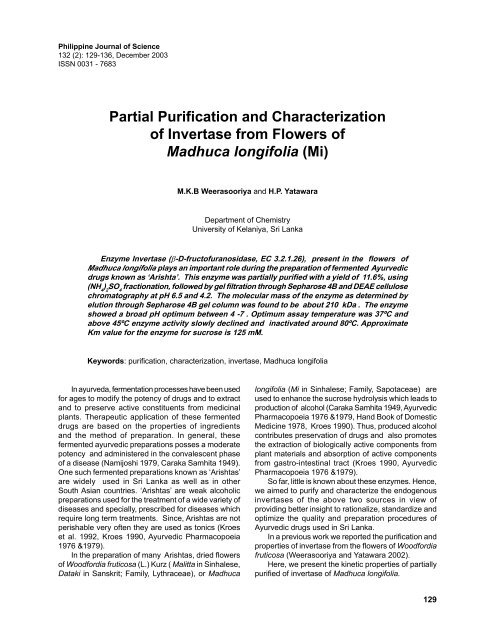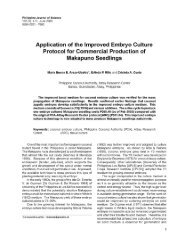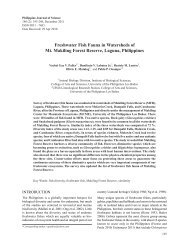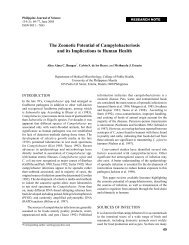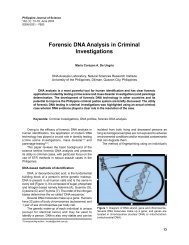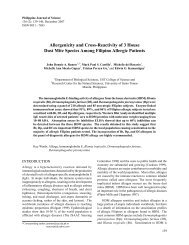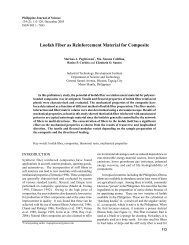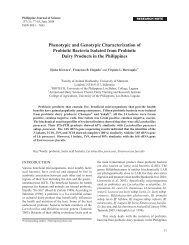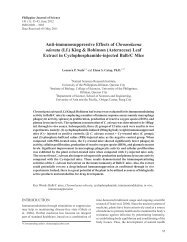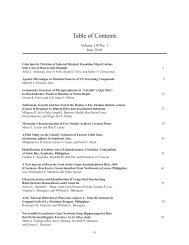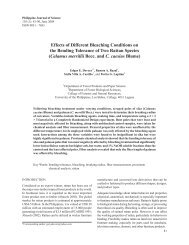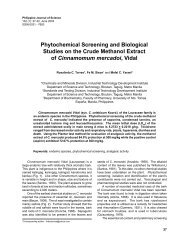Partial Purification and Characterization of Invertase - Philippine ...
Partial Purification and Characterization of Invertase - Philippine ...
Partial Purification and Characterization of Invertase - Philippine ...
Create successful ePaper yourself
Turn your PDF publications into a flip-book with our unique Google optimized e-Paper software.
<strong>Philippine</strong> Journal <strong>of</strong> Science132 (2): 129-136, December 2003ISSN 0031 - 7683<strong>Partial</strong> <strong>Purification</strong> <strong>and</strong> <strong>Characterization</strong><strong>of</strong> <strong>Invertase</strong> from Flowers <strong>of</strong>Madhuca longifolia (Mi)M.K.B Weerasooriya <strong>and</strong> H.P. YatawaraDepartment <strong>of</strong> ChemistryUniversity <strong>of</strong> Kelaniya, Sri LankaEnzyme <strong>Invertase</strong> (β-D-fruct<strong>of</strong>uranosidase, EC 3.2.1.26), present in the flowers <strong>of</strong>Madhuca longifolia plays an important role during the preparation <strong>of</strong> fermented Ayurvedicdrugs known as ‘Arishta’. This enzyme was partially purified with a yield <strong>of</strong> 11.6%, using(NH 4) 2SO 4fractionation, followed by gel filtration through Sepharose 4B <strong>and</strong> DEAE cellulosechromatography at pH 6.5 <strong>and</strong> 4.2. The molecular mass <strong>of</strong> the enzyme as determined byelution through Sepharose 4B gel column was found to be about 210 kDa . The enzymeshowed a broad pH optimum between 4 -7 . Optimum assay temperature was 37ºC <strong>and</strong>above 45ºC enzyme activity slowly declined <strong>and</strong> inactivated around 80ºC. ApproximateKm value for the enzyme for sucrose is 125 mM.Keywords: purification, characterization, invertase, Madhuca longifoliaIn ayurveda, fermentation processes have been usedfor ages to modify the potency <strong>of</strong> drugs <strong>and</strong> to extract<strong>and</strong> to preserve active constituents from medicinalplants. Therapeutic application <strong>of</strong> these fermenteddrugs are based on the properties <strong>of</strong> ingredients<strong>and</strong> the method <strong>of</strong> preparation. In general, thesefermented ayurvedic preparations posses a moderatepotency <strong>and</strong> administered in the convalescent phase<strong>of</strong> a disease (Namijoshi 1979, Caraka Samhita 1949).One such fermented preparations known as ‘Arishtas’are widely used in Sri Lanka as well as in otherSouth Asian countries. ‘Arishtas’ are weak alcoholicpreparations used for the treatment <strong>of</strong> a wide variety <strong>of</strong>diseases <strong>and</strong> specially, prescribed for diseases whichrequire long term treatments. Since, Arishtas are notperishable very <strong>of</strong>ten they are used as tonics (Kroeset al. 1992, Kroes 1990, Ayurvedic Pharmacopoeia1976 &1979).In the preparation <strong>of</strong> many Arishtas, dried flowers<strong>of</strong> Woodfordia fruticosa (L.) Kurz ( Malitta in Sinhalese,Dataki in Sanskrit; Family, Lythraceae), or Madhucalongifolia (Mi in Sinhalese; Family, Sapotaceae) areused to enhance the sucrose hydrolysis which leads toproduction <strong>of</strong> alcohol (Caraka Samhita 1949, AyurvedicPharmacopoeia 1976 &1979, H<strong>and</strong> Book <strong>of</strong> DomesticMedicine 1978, Kroes 1990). Thus, produced alcoholcontributes preservation <strong>of</strong> drugs <strong>and</strong> also promotesthe extraction <strong>of</strong> biologically active components fromplant materials <strong>and</strong> absorption <strong>of</strong> active componentsfrom gastro-intestinal tract (Kroes 1990, AyurvedicPharmacopoeia 1976 &1979).So far, little is known about these enzymes. Hence,we aimed to purify <strong>and</strong> characterize the endogenousinvertases <strong>of</strong> the above two sources in view <strong>of</strong>providing better insight to rationalize, st<strong>and</strong>ardize <strong>and</strong>optimize the quality <strong>and</strong> preparation procedures <strong>of</strong>Ayurvedic drugs used in Sri Lanka.In a previous work we reported the purification <strong>and</strong>properties <strong>of</strong> invertase from the flowers <strong>of</strong> Woodfordiafruticosa (Weerasooriya <strong>and</strong> Yatawara 2002).Here, we present the kinetic properties <strong>of</strong> partiallypurified <strong>of</strong> invertase <strong>of</strong> Madhuca longifolia.129
Weerasooriya & YatawaraMaterials <strong>and</strong> MethodsApparatusMicrobiological work was carried out under sterileconditions in a Labcare microbiological cabinet.Sterilization <strong>of</strong> the culture media, glass ware <strong>and</strong> otherconsumables prior <strong>and</strong> subsequent to use was carriedout in an autoclave at 15 p.s.i for 30 minutes.ChemicalsAll the bio-chemicals were purchased from FlukaChemical company, Sweden. All other chemicals usedwere <strong>of</strong> analytical grade.Plant materialsFlowers <strong>of</strong> Madhuca longifolia (Mi) were collectedfrom the garden <strong>of</strong> Pallkelle Ayurveda Hospital. Theywere identified by Mr. D.B.M.U. Dhanasekera <strong>and</strong>Mrs.R.W. Edirisinghe by comparing with authenticsamples in the National Herbarium at PeradeniyaBotanical Gardens, K<strong>and</strong>y. The collected flowers werecleaned <strong>and</strong> stored in the refrigerator.Enzyme purificationAll the purification steps were carried out at roomtemperature unless otherwise specified.Preparation <strong>of</strong> the crude extractMicroorganisms presence on the surface <strong>of</strong> theMadhuca longifolia flowers were removed by washingthe flowers with sterile distilled water. In each washing,the flowers were shaken for about 30 minutes <strong>and</strong> thisprocess was continued for nearly 55 times. The flowers(120 g) were next immersed in citrate buffer (pH 5.2,50 mM, 75.0 ml) containing 1 mM EDTA <strong>and</strong> 5 mM2-mercaptoethanol , ground with mortar <strong>and</strong> pestle<strong>and</strong> the crude extract thus obtained was centrifugedat 15,000 g for 30 minutes at 1°C. The supernatantsolution was filtered through a sterile filter paper, (0.22µm). A small aliquot which obtained from the filtrateswas cultured in nutrient Agar (NA) <strong>and</strong> potato dextroseagar (PDA) <strong>and</strong> incubated for 2 days at 37°C to checkfor the presence <strong>of</strong> any micr<strong>of</strong>lora.Since, no micr<strong>of</strong>lora was observed, above filtratewas used for the following ammonium sulphatefractionation.(NH 4)2 SO 4 fractionation<strong>Invertase</strong> in the crude extract was precipitatedat 1°C between 50-95% saturation <strong>of</strong> (NH 4)2 SO 4 ,centrifuged at 12,000g for 30 min <strong>and</strong> resuspended incitrate buffer (pH 5, 50mM) containing 1mM EDTA <strong>and</strong>5mM 2-mercaptoethanol. The enzyme preparationswere then stored in the freezer until required for furtherpurification <strong>and</strong> other analysis.Sepharose 4B gel filtration chromatographyEnzyme fraction was further purified by passingthrough a Sepharose-4B column (58x2cm) <strong>and</strong> elutedwith citrate buffer (pH 5.2, 50mM) containing 1mMEDTA, 5mM 2-mercaptoethanol <strong>and</strong> 50mM NaCl at aflow rate <strong>of</strong> 20ml/hr. Fractions (2 ml) were collected <strong>and</strong>the enzyme activity was assayed.DEAE Cellulose chromatography at pH 6.5Active fractions eluted from sepharose-4B columnwere pooled <strong>and</strong> purified on a DEAE Cellulose column(12x 3cm) eluting with phosphate buffer (50mM, pH 6.5)containing 1mM EDTA <strong>and</strong> 5mM 2-mercaptoethanol.The enzyme was eluted with same buffer at a flow rate<strong>of</strong> 20ml/hr. Fractions (1.5 ml) were collected <strong>and</strong> theenzyme activity was assayed.DEAE Cellulose chromatography at pH 4.2Active fractions were pooled <strong>and</strong> chromatographedon second DEAE column (9 x 2.2 cm) eluting at a flowrate <strong>of</strong> 18ml/hr, with a linear gradient <strong>of</strong> 0-1M NaCl addedto citrate buffer (50mM citrate, pH 4.2) containing 1mMEDTA <strong>and</strong> 5mM 2-mercaptoethanol. Fractions (1.5 ml)were collected <strong>and</strong> the enzyme activity was assayed.The active fractions were pooled <strong>and</strong> concentrated byosmosis against solid polyethylene glycol.Sepharose 4B gel filtration chromatography(final step)Concentrated enzyme fraction was further purifiedby passing through a sepharose 4B column (12 x 1 cm)eluted with citrate buffer (pH 5.2, 50mM) containing1mM EDTA, 5mM 2-mercaptoethanol <strong>and</strong> 150mMNaCl. Fractions (1.0 ml) were collected <strong>and</strong> the enzymeactivity was assayed.Protein estimationQuantitative estimation <strong>of</strong> protein after each step<strong>of</strong> purification was done by Bradford method (Scopes1982) using bovine serum albumin as the st<strong>and</strong>ardprotein.<strong>Invertase</strong> AssayActivity <strong>of</strong> invertase was assayed by Nelson’smethod as follows:The reaction mixture in a total volume <strong>of</strong> 2.5mlcontained citrate buffer (100mM, pH 5, 1.3ml)containing 1mM EDTA <strong>and</strong> 5mM 2-mercaptoethanol<strong>and</strong> sucrose (5%, 1.00 ml) . The reaction carried out at37 °C for 3 min, was initiated by the addition <strong>of</strong> enzyme(200µl , 1 nkat). Then Nelson’s reagent (1.00ml) was130
<strong>Partial</strong> <strong>Purification</strong> <strong>and</strong> <strong>Characterization</strong> <strong>of</strong> <strong>Invertase</strong> <strong>of</strong> M. longifolia flowersadded to the reaction mixture, boiled for 20 minutes<strong>and</strong> cooled to room temperature. Arseno-molybdatereagent (1.00 ml) was added <strong>and</strong> the mixture wasdiluted with water up to 10ml. Then absorbance wasmeasured at 510 nm.The st<strong>and</strong>ard curve was constructed for knownconcentration <strong>of</strong> product glucose against the absorbance<strong>and</strong> the amount <strong>of</strong> glucose was determined. Theenzyme activity is expressed as as nmole <strong>of</strong> sucrosereacted min -1 under specified conditions.Determination <strong>of</strong> the molecular weightThe molecular mass <strong>of</strong> the purified enzymewas estimated by gel filtration through a column <strong>of</strong>Sepharose 4B, which had previously been calibratedwith Urease (340 kDa), Alcohol Dehydrogenase (141kDa), Bovine Serum Albumin (66 kDa), Egg albumin (45kDa), Pepsin (34 kDa) <strong>and</strong> Trypsin (24 kDa).For the characterisation <strong>of</strong> the purified enzyme,following experiments were carried out under thest<strong>and</strong>ard assay conditions (1 nkat in assay). All theexperiments were performed three times in duplicatesunder the same conditions <strong>and</strong> mean st<strong>and</strong>ard deviationwere calculated.PH optimaThe optimum pH was determined by assaying theenzyme activity at different pH ranging from 2.6 to9.49 using the buffers glycine-HCl (pH 2.6), Citric acid-Na 2HPO 4(pH 3-7.5) <strong>and</strong> Tris-HCl (pH 8-8.9). Blankdeterminations were done simultaneously at all pH’swithout the enzyme.Temperature optimaThe optimum temperature was studied by assayingthe enzyme at different incubation temperaturesranging from 25°C to 65°C. Blank determinations weredone simultaneously at all temperatures without theenzyme.Thermal denaturationThermal stability <strong>of</strong> the purified enzyme was studiedby pre-incubating 1nkat <strong>of</strong> the enzyme at differenttemperatures ranging from 40 °C-100 °C for 30 min.Samples were cooled immediately in ice-water <strong>and</strong> theresidual enzyme activity was determined.Determination <strong>of</strong> KmKm value was obtained by assaying the invertaseactivity <strong>of</strong> purified preparation with sucrose as asubstrate at concentrations ranging from 10mM to250 mM.Results <strong>and</strong> DiscussionPreparation <strong>of</strong> the crude enzyme extractThe flowers were ground merely to disrupt onlythe plant tissues without harming the cellulolic walls<strong>of</strong> micro-organisms, if any present in the flowers. Thisstep would avoid the release <strong>of</strong> microbial invertase intothe extracting solution.Subsequent filtering the above enzyme extractsthrough 0.22µm sterile filter under sterile conditions wasaimed at eliminating any micro-organisms, conidia orspores which could be present in the extract.<strong>Purification</strong>The enzyme was partially purified about 51.6fold by ammonium sulphate fractionation followed bygel filtration <strong>and</strong> anion exchange chromatography.The results <strong>of</strong> the enzyme purification are given inTable 1.During the purification by DEAE column at pH 6.5the enzyme didn’t bind to the column <strong>and</strong> was elutedbefore applying the gradient. However, at this DEAEstep enzyme showed purification <strong>of</strong> 15.95 fold with54.2% recovery. As the pH was changed to pH to 4.2.Table 1. <strong>Purification</strong> <strong>of</strong> invertase from Madhuca longifoliaStepTotal Protein (mg)Specific activity(nkat mg -1 protein)Recovery%Purfication fold(NH 4) 2SO 2Step585.2 0.42 100 1Gel filtration(1 st step)107.6 1.95 85.3 4.64Ion exchangeAt pH 6.519.9 6.7 54.2 15.95Ion exchangeAt pH 4. 25.48 11.95 26.6 22.6Gel filtration(2 st step) 1.32 21.7 11.6 51.6131
Weerasooriya & YatawaraTable 2. Properties <strong>of</strong> <strong>Invertase</strong> from Madhuca longifoliaPropertyMolecular mass (kDa) 210Optimum pH 4- 7Optimum temperature 37°CKm (37°C, pH 5)Thermal stability125 mMEnzyme is stable up to 45°C.Beyond this point activity is slowlydeclined <strong>and</strong> inactivated around80° Cthe enzyme retained in DEAE column. Upon gradientelution, the enzyme showed activity peak at 0.42MNaCl.In the final purification step, reloading the activeenzyme fractions (obtained from above DEAE step)on Sepharose 4B gave a slightly broader peak.Native PAGE <strong>of</strong> this enzyme fraction (obtainedafter fractionation through final Sepharose 4Bcolumn) showed that enzyme has been partiallypurified.Molecular weightNative molecular mass <strong>of</strong> the enzyme as determinedby elution through Sepharose 4B gel filtration ~210kDa(Fig. 1). Interestingly this value falls in the molecularmass range that reported invertases from Woodfordiafruticosa, another invertase source used for thepreparation <strong>of</strong> arishta (Weerasooriya <strong>and</strong> Yatawara2002), banana fruit (Sum et al. 1980) , Iraqui date fruit(Mahrouf & Zerki 1982), rice grains (Chang et al. 1994)<strong>and</strong> sprouting soya bean (Chen & Black 1992) .Optimum pHThe purified invertase <strong>of</strong> Madhuca was quite stable<strong>and</strong> showed broad pH optimum between 4.0 - 7.0(Fig. 2) which was quite comparable to that reportedfor invertases from Woodfordia (Weerasooriya <strong>and</strong>Yatawara 2002), Iraqui date fruit (Mahrouf & Zerki1982), Allocasia leaves (Nakasone & Yasui 1982),Ricinus communis (Prado et al. 1985 ) <strong>and</strong> sugarcaneleaf (Minouru 1942).Optimum temperatureEnzyme showed a higher enzyme activity in therange <strong>of</strong> 30ºC to 45ºC with a maximum <strong>of</strong> 37ºC (Fig.3)which was very close to that reported for invertases5.85.65.4Log Molecular Weight5.254.84.64.44.240 4 8 12 16 20 24 28 32 36 40 44 48Elution volume (ml)Figure 1. Determination <strong>of</strong> the molecular weight <strong>of</strong> <strong>Invertase</strong> <strong>of</strong> Madhuca longifolia (Urease 340kDa, Alcohol dehydrogenase141kDa, Bovine serum albumin 66kDa, Egg albumin 45kDa, pepsin 34kDa <strong>and</strong> Trypsin 24kDa were used as the st<strong>and</strong>ards).132
<strong>Partial</strong> <strong>Purification</strong> <strong>and</strong> <strong>Characterization</strong> <strong>of</strong> <strong>Invertase</strong> <strong>of</strong> M. longifolia flowers4035<strong>Invertase</strong> activity (nmole/min)3025201510502.07 3.07 4.03 5.11 6.12 7.04 8.06 8.97pH valueFigure 2. <strong>Invertase</strong> activity <strong>of</strong> Madhuca longifolia as a function <strong>of</strong> pH (pH 2.6 glycine HCl 100mM; pH 3-7.5 Citric acid-Na 2HPO 4100mM; pH 8-8.9 Tris-HCl 100mM; 37°C, 3min, Mean <strong>and</strong> st<strong>and</strong>ard deviation were determined from six replicates.)3530<strong>Invertase</strong> activity (nmole/min)252015105020 30 35 37 40 50 55 60 65 70 75Incubation temperature 0 CFigure 3. <strong>Invertase</strong> activity <strong>of</strong> Madhuca longifolia as a function <strong>of</strong> incubation temperature 0.1M citrate pH 5, temeperaturerange 25-65°C, 3 min, Mean <strong>and</strong> st<strong>and</strong>ard deviation were determined from six replicates).133
Weerasooriya & Yatawara<strong>of</strong> Woodfordia (Weerasooriya <strong>and</strong> Yatawara 2002),Allocasia leaves (Nakasone & Yusai 1982), sugarcaneleaf (Minouru 1942) <strong>and</strong> sugar beet (Bohuslavska etal. 1984 ) .Thermal inactivationBeyond 45ºC, invertase activity <strong>of</strong> Madhucaslowly declined <strong>and</strong> became almost nil by 80ºC (Fig.4)similar to that reported for invertases <strong>of</strong> Woodfordia(Weerasooriya <strong>and</strong> Yatawara 2002), Allocasia leaves(Chen & Black 1992) <strong>and</strong> potato tubers (Isla et al. 1998). However, invertase <strong>of</strong> Madhuca seems to be moreheat sensitive than invertases <strong>of</strong> muscat bailey A grapes(Porntaveewat et al. 1994), semillon grapes (Nakanishiet al. 1991) <strong>and</strong> yeast particularly, Saccharomycesecerevisae (Raheja et al. 1998) <strong>and</strong> Saccharomycesefragilis (Kulikora 1986) which were reported to be stableup to 80ºC.Kinetic constants (km)The Km values <strong>of</strong> purified Madhuca invertase forsucrose was found to be ~ 125 mM which was very closeto the values that reported for invertases <strong>of</strong> Woodfordia,(Weerasooriya <strong>and</strong> Yatawara 2002). invertases fromSolanum tuberosum tubers (Isla et al. 1999) <strong>and</strong> higherthan Km values that reported for invertases <strong>of</strong> ricegrain (Km ~ 70mM) (Chang et al. 1994), <strong>and</strong> potatotubers (Km ~ 100mM) (Isla et al. 1998).In a summary, <strong>Invertase</strong> from Madhuca longifoliafits many characteristics described for invertaseisolated from Woodfordia fruticosa (another invertasesource which used for the preparation <strong>of</strong> Arishta)such as optimum pH, optimum temeperature, thermalstability, molecular mass <strong>and</strong> Km value. Km <strong>of</strong>Woodfordia invertase for sucrose is reported to be~160 mM whereas that <strong>of</strong> Madhuca invertase foundto be ~125mM. This indicates possibly substratesucrose shows higher affinity towards Madhucainvertase rather than that <strong>of</strong> Woodfordia. All arishtapreparations in Sri Lanka are carried out at roomtemperature which is around 35-37ºC . This is inagreement with the temperature 37ºC which showsthe optimum activity <strong>of</strong> the enzyme. pH <strong>of</strong> the solutionis also very importance during the preparation <strong>of</strong>Arishta. As described in Kroes 1990, all arishtapreparations favour the weak acidic condition.Alkaline conditions are unfavourable for the reaction.This is in agreement with optimum pH <strong>of</strong> the enzyme.As reported by Kroes 1992, high content <strong>of</strong> gallicacid, (a weak acid present in preparation medium)presumably maintain the pH <strong>of</strong> the solution around 4-60<strong>Invertase</strong> activity (nmole/min)5040302010050 60 70 80 90 100Temperature 0 CFigure 4. Thermal stability <strong>of</strong> invertase <strong>of</strong> Madhuca longifolia (Incubation <strong>of</strong> 1nkat <strong>of</strong> enzyme in 0.1M citrate buffer pH 5 for30 min at different temperature 40-100°C <strong>and</strong> then measured for activity under st<strong>and</strong>ard conditions; 0.1M citrate pH 5, 37°C,3min, Mean <strong>and</strong> st<strong>and</strong>ard deviation were determined from six replicates).134
<strong>Partial</strong> <strong>Purification</strong> <strong>and</strong> <strong>Characterization</strong> <strong>of</strong> <strong>Invertase</strong> <strong>of</strong> M. longifolia flowers201/rate x 10 -2 (nmole/min) -1151050-25 -5 15 35 55 75 95 115-51/[Substrate](M) -1Figure 5. Determination <strong>of</strong> Km <strong>of</strong> Madhuca invertase - (Line-Weaver Burk plot; 0.1M citrate pH 5, 37°C, 3min, substrateconcentration ranging from 10-250mM; Mean <strong>and</strong> st<strong>and</strong>ard deviation were determined from six replicates.)7 in order to provide optimum activity <strong>of</strong> the enzyme.Apart from these data further information particularlyon the inhibitors <strong>of</strong> two enzymes are to be obtained.All these data will enable to upgrade the quality <strong>and</strong>preparation procedures <strong>of</strong> all arishtas in Sri Lankaas well as in India.AcknowledgementsNational Science Foundation, Sri Lanka isacknowledged for the financial support.ReferencesAyurvedic Pharmacopoeia Vol. I, part I (1976), part2 (1979). Department <strong>of</strong> Ayurveda, Colombo, SriLanka.Bohuslavska M, Zahradnicek J, MichaljanicovaD & Kotyk A. 1984. Effects <strong>of</strong> chemical <strong>and</strong>physiochemical factors on sugar beat invertaseactivity. Biol. Plant, 26 (4): 303-8.Caraka Samhita (Engl. Transl.) 1949. ShreeGulabkunverba Ayurvedic Society, Jamagun,India.Chang YY, Yjuang RH, Su JC & Sung HY. 1994.<strong>Partial</strong> purification <strong>and</strong> characterization <strong>of</strong> invertaseisozymes from rice grains. Biochem. Mol. Biol.33(3): 607-15.Chen JQ & Black CC. 1992. Biochemical <strong>and</strong>Immunological properties <strong>of</strong> alkaline invertase fromsoya bean hypocotyls. Arch. Biochem. Biophysics.15: 295 (1), 61-9.H<strong>and</strong> Book <strong>of</strong> Domestic Medicine <strong>and</strong> CommonAyurvedic Remedies (1978). Central Council forResearch in Indian Medicine <strong>and</strong> Homeopathy,Ministry <strong>of</strong> Health <strong>and</strong> Family Welfare, New Delhi,pp. 334-335.Isla MI, Vattuone MA & Sampietro AR. 1998.Hydrolysis <strong>of</strong> sucrose within isolated vacuolesfrom Solanum tuberosum L.tubers. Planta.205(4): 601-5.Isla MI, Vattuone MA, Ordonez RM & Sampietro AR.1999. <strong>Invertase</strong> activity associated with the walls<strong>of</strong> Solanum tuberose tubers. Phytochemistry.50(4): 525.Kroes BH. 1990. “Nimba Arishta; impact <strong>of</strong> thepreparation process on chemical parameters <strong>and</strong>immnunomodulatory activity’’ Ph.D. Thesis University<strong>of</strong> Uretch. Netherl<strong>and</strong>.135
Weerasooriya & YatawaraKroes BH, Van den Berg AJJ, De Silva KTD &Labadie RP. 1992. Investigation on Nimba Arishta,an immunomodulating ayurvedic drug obtainedby Fermentation. Journal <strong>of</strong> European AyurvedicSociety. 2. 123-133.Kroes BH, Van den Berg AJJ, Abeysekara AM, De SilvaKTD & Labadie RP. 1993. Fermentation in traditionalmedicine: the impact <strong>of</strong> Woodfordia fruticosa theimmnomodulatory activity, <strong>and</strong> the alcohol <strong>and</strong>sugar contents <strong>of</strong> Nimba Arishta. Journal <strong>of</strong>Ethnopharmacology. 40. 117-125.Kulikora AK, Chichua VG & Tsereteli AK. 1986.<strong>Purification</strong> <strong>of</strong> intracellular invertase fromSaccharomyces fragilis. Prikl. Biokhim. Mikrobiol.22 (5): 648.Mahrouf BA & Zeki L. 1982. Isolation <strong>and</strong> characterisation<strong>of</strong> <strong>Invertase</strong> from Iraqui date fruit. J. Food Sci. 47(2): 678-9.Minouru F. 1942. Studies <strong>of</strong> sugar cane invertase Leafinvertase. J. Agric. Chem. Soc. Japan. 18. 961-4.Nadkarni KM. 1954. Indian Materia Medica Vol.2, 3rdedn., Popular Book Depot, Bombay, India, pp.489-497.Nakanishi K, Wu W & Yokotuska K. 1991. <strong>Purification</strong><strong>and</strong> properties <strong>of</strong> thermostable invertase from wine.J. Ferment. Bioeng. 71 (1): 66-68.NakasoneY & Yasui M. 1982. <strong>Invertase</strong> from Allocasialeaves. Ryukyu Daigaku Nogakubu GakujustuHokoku. 29. 73-8.Namjoshi A. 1979. Ayurvedic pharmacopoeia <strong>and</strong>its drugs st<strong>and</strong>arization. In: Realms <strong>of</strong> Ayurveda.S. Shrama (Ed.), Arnold-Heineman, New Delhi,pp.217-238.Porntaveewat W, Takayanagi T & Yokotsuka K. 1994.<strong>Purification</strong> <strong>and</strong> properties <strong>of</strong> invertase from MuscatBailey A grapes. J. Ferment. Bioeng. 78 (4): 288-92.Prado FE, Vattuone MA, Fleuschmacher OL &Sampietro AR 1985. <strong>Purification</strong> <strong>and</strong> characterisation<strong>of</strong> Ricinus communis invertase. J.Biol.Chem. 260 (8).4952-7.Raheja G, Gill RK, Kumar S, Mahmood S & MahmoodA. 1998. Effect <strong>of</strong> sodium on Saccharomycescerevisiae invertase activity. Indian. J. Exp. Biol. 36(5): 493-6.Scopes R. 1982. Protein purification principles <strong>and</strong>practice, Springer-Verlag, New York: p.266Sum WF, Rogers PJ, Jenkins LD & Guthrie RD.1980. Isolation <strong>of</strong> invertase from banana fruit,Phytochemistry 19 (30): 399-401.Weerasooriya MKB & Yatawara HP 2002. <strong>Purification</strong><strong>and</strong> properties <strong>of</strong> <strong>Invertase</strong> from Woodfordiafruticosa, Indian J. <strong>of</strong> Biochem. <strong>and</strong> Biophy. 39(10)p.347-350136


